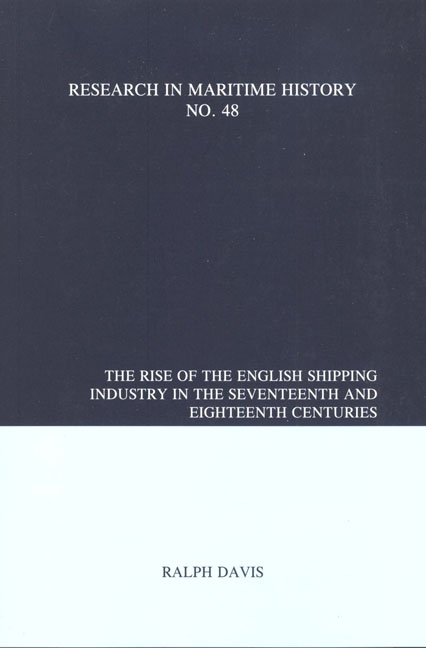Book contents
- Frontmatter
- Contents
- Introduction to the 2012 Edition
- Series Editor's Note
- Introduction
- Preface
- Chapter 1 The Widening of Horizons, 1560-1689
- Chapter 2 Consolidation, 1689-1775
- Chapter 3 Ships and Shipbuilders in the Seventeenth Century
- Chapter 4 Ships and Shipbuilders in the Eighteenth Century
- Chapter 5 The Shipowners
- Chapter 6 The Merchant Seamen
- Chapter 7 The Pay and Conditions of Merchant Seamen
- Chapter 8 Shipping Management and the Role of the Master
- Chapter 9 Shipping and Trade
- Chapter 10 The Nearby and Northern European Trades
- Chapter 11 The Southern European and Mediterranean Trades
- Chapter 12 The East Indian Trade
- Chapter 13 The American and West Indian Trades
- Chapter 14 The Government and the Shipping Industry
- Chapter 15 War and the Shipping Industry
- Chapter 16 Four Ships and Their Fortunes
- Chapter 17 Was It a Profitable Business?
- Chapter 18 Conclusion
- Appendix A A Note on the Shipping Statistics, 1686-1788
- Appendix B Sources for the History of the Shipping Industry
- Index
Chapter 12 - The East Indian Trade
- Frontmatter
- Contents
- Introduction to the 2012 Edition
- Series Editor's Note
- Introduction
- Preface
- Chapter 1 The Widening of Horizons, 1560-1689
- Chapter 2 Consolidation, 1689-1775
- Chapter 3 Ships and Shipbuilders in the Seventeenth Century
- Chapter 4 Ships and Shipbuilders in the Eighteenth Century
- Chapter 5 The Shipowners
- Chapter 6 The Merchant Seamen
- Chapter 7 The Pay and Conditions of Merchant Seamen
- Chapter 8 Shipping Management and the Role of the Master
- Chapter 9 Shipping and Trade
- Chapter 10 The Nearby and Northern European Trades
- Chapter 11 The Southern European and Mediterranean Trades
- Chapter 12 The East Indian Trade
- Chapter 13 The American and West Indian Trades
- Chapter 14 The Government and the Shipping Industry
- Chapter 15 War and the Shipping Industry
- Chapter 16 Four Ships and Their Fortunes
- Chapter 17 Was It a Profitable Business?
- Chapter 18 Conclusion
- Appendix A A Note on the Shipping Statistics, 1686-1788
- Appendix B Sources for the History of the Shipping Industry
- Index
Summary
Though a good deal has been written on the shipping affairs of the East India Company, nearly all of it relates to the last years of the eighteenth and to the nineteenth century, and impressions derived from this period will mislead if they are incautiously applied to earlier times.
The English East India trade was opened by the voyage of Red Dragon, Hector, Ascension and Susan, which sailed for Java and Sumatra in 1601. The import trade in pepper and spices from the Indonesian Archipelago, which they inaugurated, was savagely contested by the Dutch, who by 1623 had driven the English out of all this area except a weak foothold at Bantam in Java. A more secure start was made on the Indian coast, at Surat in the territory of the Mogul Emperor, in 1607, and English trade with India was gradually expanded during the seventeenth century despite Portuguese, Dutch and later French competition. New trading stations were established, notably those of Madras (1639), Bombay (1662) and Calcutta (1686). Trade was soon developed, too, with ports of the Persian Gulf and the southern part of the Red Sea.
From the early trading bases two principal bulk commodities were drawn; pepper from the East Indies and the Malabar Coast, and saltpetre from northern India. A wide variety of other goods of much greater total value came in - silk and cotton fabrics, indigo, drugs of all kinds - but pepper and saltpetre constituted most of the volume of every ship's cargo. When Berkeley Castle sailed for home in 1681 “reputed for Cargo the richest Ship which ever went out of Madras Road,” its cargo was worth some £80,000, but well over half the tonnage aboard consisted of saltpetre, which contributed only a negligible amount to this great value. Exports were very limited; some cloth, a good deal of lead and iron ballast (much of it coming all the way home again), a little iron- and brass-ware, beer and a vast wealth of bullion.
- Type
- Chapter
- Information
- The Rise of the English Shipping Industry in the Seventeenth and Eighteenth Centuries , pp. 247 - 256Publisher: Liverpool University PressPrint publication year: 2012



